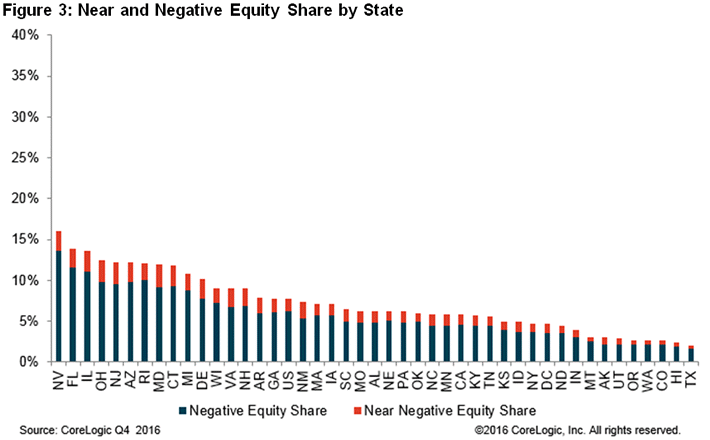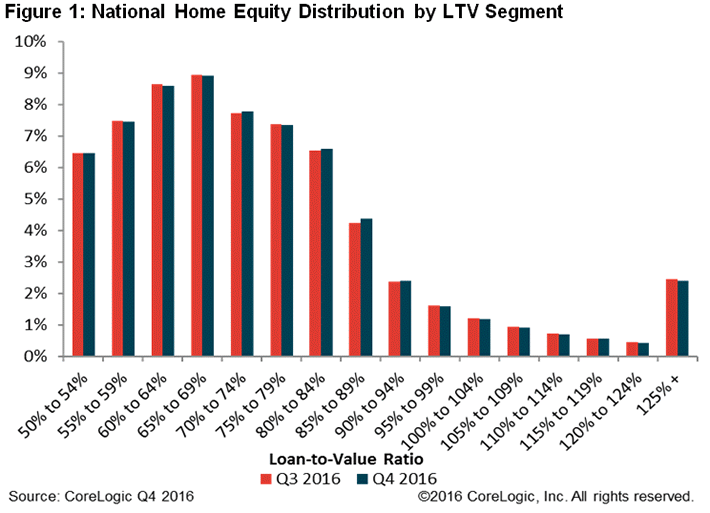The once-epidemic level of underwater properties retreated further into history in 2016 as another 1 million homeowners regained equity in their homes. CoreLogic said on Thursday that 48 million homes, about 93.8 percent of those with a mortgage, now have positive equity. Negative equity peaked at 26 percent of mortgaged residential properties in Q4 2009 based on the company's equity data analysis, which began in Q3 2009.
Negative equity, often referred to as being "underwater" or "upside down," applies to borrowers who owe more on their mortgages than their homes are worth. Negative equity can occur because of a decline in home value, an increase in mortgage debt or both.
The mortgaged homes that remained in negative territory at the end of the fourth quarter of 2016 numbered 3.17 million, a 6.2 percent rate. This is down 2 percent from the third quarter's total of 3.23 million homes or 6.3 percent of all mortgaged homes, and down 25 percent from the fourth quarter of 2015 when there were 4.23 million homes without equity.
Those remaining properties lacking equity represent an aggregate of $283 in negative value, down from the third quarter by approximately $700 million and a decrease of $26 billion from $308.9 billion in the 4th quarter of the previous year. Nationwide, homeowners with a mortgage (about 63 percent of all homeowners) gained $783 billion in equity over the year, an increase of 11.7 percent. On average, equity increased about $13,700 from Q4 2015 to Q4 2016 (for mortgaged properties). Washington had an average increase of $31,000, while Delaware experienced a small decline.
Dr. Frank Nothaft, chief economist for CoreLogic, said "The equity build-up has been supported by home-price growth and paydown of principal. The CoreLogic Home Price Index for the U.S. rose 6.3 percent over the year ending December 2016. Further, about one-fourth of all outstanding mortgages have a term of 20 years or less, which amortize more quickly than 30-year loans and contribute to faster equity accumulation."

The highest percentage of homes with negative equity continues to be in Nevada which was among states hardest hit by price declines and foreclosures starting in 2008. Of mortgaged homes in that state, 13.6 percent are underwater. Florida follows at 11.6 percent; Illinois (11.1 percent), Rhode Island (10 percent) and Arizona (9.8 percent) round out the top five. These states combined account for 29.7 percent of negative equity in the U.S., but only 16.3 percent of outstanding mortgages.
Texas had the highest percentage of homes with positive equity at 98.4 percent, followed by Hawaii (98.1 percent), Alaska (97.9 percent), Colorado (97.9 percent), Oregon (97.9 percent), Utah (97.9 percent) and Washington (97.9 percent).

"Home equity gains were strongest in faster-appreciating and higher-priced home markets," said Frank Martell, president and CEO of CoreLogic. "The states with the largest home-price appreciation last year, according to the CoreLogic Home Price Index, were Washington and Oregon at 10.2 percent and 10.3 percent, respectively, with average homeowner equity gains of $31,000 and $27,000, respectively. This is double the pace for the U.S. as a whole. And while statewide home-price appreciation was slower in California at 5.8 percent, the high price of housing there led to California homeowners gaining an average of $26,000 in home equity wealth last year."







